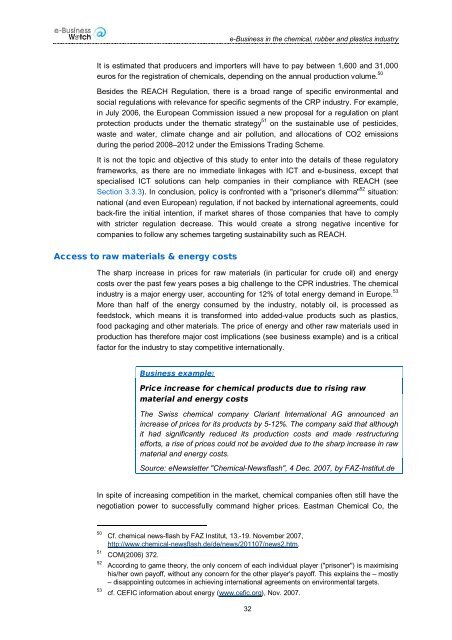Downloads - empirica
Downloads - empirica
Downloads - empirica
Create successful ePaper yourself
Turn your PDF publications into a flip-book with our unique Google optimized e-Paper software.
e-Business in the chemical, rubber and plastics industryIt is estimated that producers and importers will have to pay between 1,600 and 31,000euros for the registration of chemicals, depending on the annual production volume. 50Besides the REACH Regulation, there is a broad range of specific environmental andsocial regulations with relevance for specific segments of the CRP industry. For example,in July 2006, the European Commission issued a new proposal for a regulation on plantprotection products under the thematic strategy 51 on the sustainable use of pesticides,waste and water, climate change and air pollution, and allocations of CO2 emissionsduring the period 2008–2012 under the Emissions Trading Scheme.It is not the topic and objective of this study to enter into the details of these regulatoryframeworks, as there are no immediate linkages with ICT and e-business, except thatspecialised ICT solutions can help companies in their compliance with REACH (seeSection 3.3.3). In conclusion, policy is confronted with a "prisoner's dilemma" 52 situation:national (and even European) regulation, if not backed by international agreements, couldback-fire the initial intention, if market shares of those companies that have to complywith stricter regulation decrease. This would create a strong negative incentive forcompanies to follow any schemes targeting sustainability such as REACH.Access to raw materials & energy costsThe sharp increase in prices for raw materials (in particular for crude oil) and energycosts over the past few years poses a big challenge to the CPR industries. The chemicalindustry is a major energy user, accounting for 12% of total energy demand in Europe. 53More than half of the energy consumed by the industry, notably oil, is processed asfeedstock, which means it is transformed into added-value products such as plastics,food packaging and other materials. The price of energy and other raw materials used inproduction has therefore major cost implications (see business example) and is a criticalfactor for the industry to stay competitive internationally.Business example:Price increase for chemical products due to rising rawmaterial and energy costsThe Swiss chemical company Clariant International AG announced anincrease of prices for its products by 5-12%. The company said that althoughit had significantly reduced its production costs and made restructuringefforts, a rise of prices could not be avoided due to the sharp increase in rawmaterial and energy costs.Source: eNewsletter "Chemical-Newsflash", 4 Dec. 2007, by FAZ-Institut.deIn spite of increasing competition in the market, chemical companies often still have thenegotiation power to successfully command higher prices. Eastman Chemical Co, the50515253Cf. chemical news-flash by FAZ Institut, 13.-19. November 2007,http://www.chemical-newsflash.de/de/news/201107/news2.htm.COM(2006) 372.According to game theory, the only concern of each individual player ("prisoner") is maximisinghis/her own payoff, without any concern for the other player's payoff. This explains the – mostly– disappointing outcomes in achieving international agreements on environmental targets.cf. CEFIC information about energy (www.cefic.org), Nov. 2007.32
















